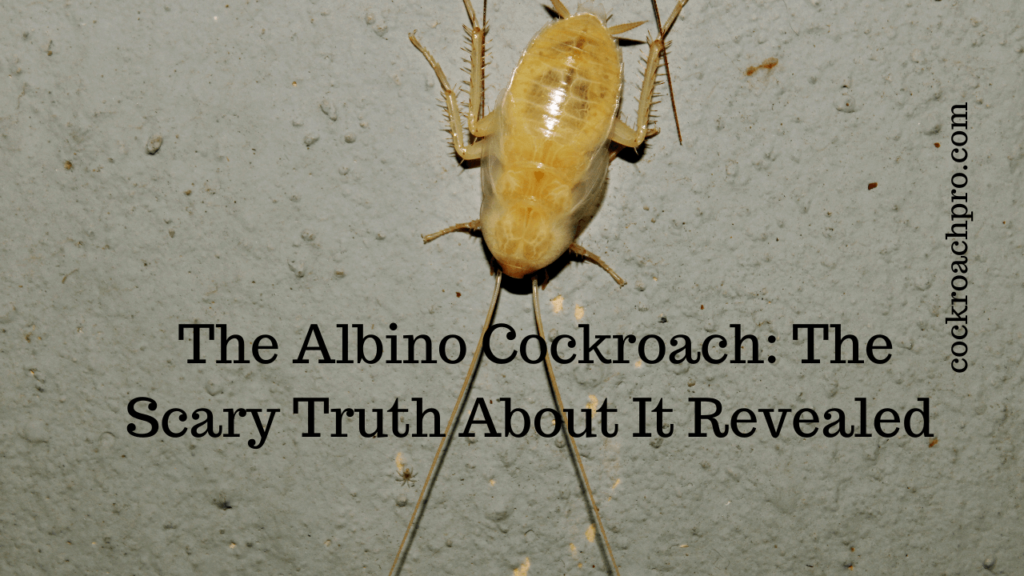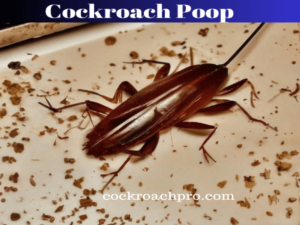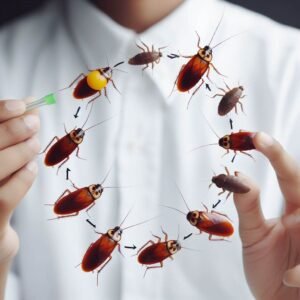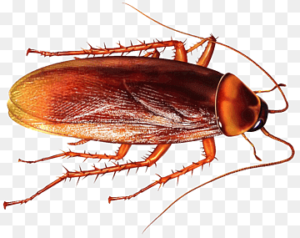A white cockroach: Cockroaches rank high on most people’s list of unwanted pests as far as i know.
The sneaky insects love invading our homes in search of food, water, warmth and shelter. While cockroach infestations cause dismay under normal circumstances, the situation goes up a notch for homeowners unsettled to find white cockroaches creeping around their dwellings.
What causes cockroaches to appear white in color? Do they pose special concerns compared to regular brown roaches? And what steps must you take if you spot one of these odd-looking bugs? This guide breaks down the key facts everyone should know about white cockroaches.
What is White Cockroach?
White cockroach represents a genetic color variation of the common household pest cockroach species Blattella asahinai, also known as the Asian cockroach. Like typical brown roaches, they originated in tropical climates but spread via international trade routes to establish footholds globally.
The variation causing white coloration stems from a mutation preventing formation of the normal brown melanin pigment. So these albino-like bugs lack the dark coloration and instead display a pale white hue.
They occur rarely compared to conventional brown roaches. But they remain the same species, with similar behavior, diet and habitat preferences.
Is white cockroach same as albino roach?
Yes, white cockroaches are the same as albino cockroaches. The terms “white cockroach” and “albino cockroach” both refer to the same genetic variant of common household pest cockroaches that lack the usual pigmentation.
Albinism is the congenital condition characterized by a deficiency or complete absence of melanin pigment in skin, eyes, hair, scales, feathers, etc. resulting in white or very pale coloration. Albino animals and insects occur due to genetic mutations that disrupt normal melanin synthesis during development.
Similarly, white cockroaches arise from a mutation that blocks melanin formation in roaches, preventing them from acquiring the typical brown-black hue. This causes them to express the natural white tone of their exoskeletons and bodies instead, resulting in albino-like, pale white coloration.
So while not all white insects necessarily have true albinism, white cockroaches do qualify as albino variants within their species since they carry a proven mutation interfering with melanin production. They display the same clinical absence of melanin pigment and associated visual traits as evident in albino mammals and other organisms.
In summary, the white color morphs of common household pest cockroaches match the scientific definition of albinistic animals. Therefore, white cockroaches constitute albino roaches within their own species classification. Both labels accurately characterize their pale appearance stemming from an established genetic mutation blocking normal color pigment development.

What Causes White Cockroach Coloration?
The absence of melanin pigmentation produces the white coloration observed in these unique roaches. Melanin comprises a class of natural pigments occurring across the animal kingdom that provide typically brown and black hues.
White cockroaches carry a genetic mutation blocking melanin synthesis during development, according to research published in Proceedings of the National Academy of Sciences.
Without melanin formation, the insects lack dark color, revealing the natural white tone of their exoskeletons and bodies underneath. The mutation gets passed down from parent insects that carry the relevant gene.
And when white cockroaches mate with brown ones, they can produce offspring showing a mix of white and brown spots and patterns on their bodies. But the offspring can breed true when white roaches mate together, resulting in uniformly pale-colored descendants.
How Rare Are White Cockroaches?
The occurrence of white cockroaches amounts to a relatively uncommon phenomenon compared to normal brown roaches of the same species. Scientists estimate around 1 in 10,000 cockroaches across studied populations display the white genetic color variation.
One analysis published in Annals of the Entomological Society of America found that out of over 22,000 wild-caught American cockroaches studied, only 23 showed the white coloration, highlighting the rarity value.
The prevalence does appear higher among cockroaches selectively bred in laboratories for research. But overall, the vast majority of roaches encountered by pest control operators and homeowners demonstrate the familiar brown tones.
Still, while rare, white cockroaches certainly occur in homes, apartment blocks, restaurants and other buildings in places battling roach infestations. And their pale hues draw even more revulsion and discomfort when spotted!
What do white cockroaches eat?
White cockroaches eat the same foods as regular brown cockroaches. Their dietary preferences include:
1. Starchy foods
White cockroaches thrive on starchy foods like bread, crackers, cereals, pasta, rice, flour, and potatoes. These carbohydrate-rich items offer excellent nutrition for roaches.
2. Sweets
Roaches eagerly consume any sweets left unattended, including crumbs from cakes, cookies, donuts and candy. They also lick up sugary substances like syrup, honey and jams. The sugar provides quick energy.
3. Proteins
Roaches scavenge protein from both plant and animal sources. They nibble on meat scraps, cheese, nuts, pet food and even glue from book bindings containing protein.
4. Grease and oil
Roaches depend heavily on fatty acids in oils and greases found in kitchens to meet metabolic requirements. Grease residues in ovens, stovetops and microwaves draw roaches to those appliances.
5. Paper and glue
Cellulose from paper products gets consumed along with the starch-based glues binding books and cardboard items, meeting carbohydrate needs.
6. Fruit
Fruits offer roaches sugars along with vitamins from softer ripening produce like strawberries and bananas
7. Garbage
Cockroaches forage through household garbage seeking all the above food types readily available as people waste edibles and toss out greasy packaging items.
White cockroaches exhibit opportunistic and omnivorous feeding behaviors much like typical brown roaches.
Is white cockroach poisonous?
No, white cockroaches are not poisonous. They do not bite or sting, and they do not carry any diseases that are transmissible to humans.
Like regular brown cockroaches, white cockroaches can contaminate food and surfaces with bacteria, pathogens, and allergens if allowed to propagate. Their droppings and body parts can also trigger asthma symptoms in sensitive individuals if inhaled. But they possess no innate venom or toxicity that directly harms people via poisoning.
The main health hazards posed by white or brown cockroaches relate to the unsanitary conditions and secondary infections their presence facilitates. Areas infested with roaches face higher risks of food contamination along with environmental buildup of microbes and allergens exacerbating illness among occupants. This generates the need for prompt elimination when roaches invade living spaces.
What Does It Mean If You See One in your house?
So what should homeowners make of the situation if they stumble across an oddball white cockroach or two crawling through their living spaces?
Unfortunately, spotting any roach represents bad news signaling, at minimum, problems with sanitation and the potential beginnings of an infestation if not quickly curtailed. Like conventional brown roaches, white ones live and breed predominantly indoors, closely associated with humans and the spaces we inhabit.
They need access to food and water to survive, seeking sugars, grease, starches and debris left out. Plus locations offering adequate warmth, humidity and shelter, like inside appliances, wall voids and cracks in cabinetry.
Therefore, sightings mean pathways exist allowing roaches entry and enabling them to establish colonies that can rapidly get out of control. And the presence of atypical white specimens alongside regular brown ones demonstrates roaches reside there long enough to reproduce and spread their genes.
So while shocking to behold, the white versions should get treated with equal priority to take necessary steps that eliminate roach presence.
The next section explains top ways to achieve this when faced with infestation issues.
Tips for Eliminating White Cockroaches
When attempting to rid homes and businesses of white or regular roaches, experts recommend focusing on sanitation and fixing conditions enabling infestations. Key tips include:
1. Reduce Food and Water Access
The first priority involves limiting roach access to essential food and water sources. This means:
- Clearing food debris and spills
- Storing edibles in sealed containers
- Fixing plumbing leaks reducing available water
- Taking out the trash regularly
- Cleaning dirty dishes promptly
- Securing pet food after use
Restricting food and water forces roaches to leave in search of necessity resources or die off when these get eliminated in occupied areas.
2. Use Sticky Traps
Specialized sticky traps allow for continuous trapping and effective monitoring of roach movements. The traps get positioned along walls and appliance perimeters where roaches travel.
They then get caught on the glue, immobilizing them. The traps must get checked and replaced routinely as they fill up. This method avoids spreading insecticide residue which roaches often develop resistance toward.
3. Apply Bait Stations
Boric acid or ivermectin cockroach bait stations provide another chemical-free control tactic. Roaches forage and feed on the bait back in nesting areas, leading to a gradual demise of the colony when they fail to develop properly or breed.
Repeat bait placement every few weeks, focusing on out-of-sight hotspots like below sinks and refrigerators where roaches congregate until successfully eliminated.
4. Fix Structural Issues
Caulking and sealing all cracks and crevices making entry possible removes vital harborages facilitating establishment within homes. This must accompany fixing other deficiencies like leaky plumbing and vent screens allowing outdoor roaches inside. Consult pest control experts on priority repair areas enabling thorough roach-proofing linen throughout infested spaces.
5. Call Exterminators
For advanced, recalcitrant infestations involving masses of roaches, calling professional pest control likely comprises the most effective option.
Experienced exterminators apply proven treatment regimens combining monitoring, targeted applications of gel bait and insect growth regulators plus follow up visits to ensure successful and lasting roach elimination.
Prevent Future Occurrences
Post roach eradication, continue practicing diligent sanitation and structural integrity to discourage repeat occurrences. Address conditions enabling prior infestations so roaches no longer impact daily living and white or brown outliers don’t suddenly appear!
Key takeaway
The Takeaway Coming across white cockroaches understandably heightens panic and disgust given their unusual visibility and ties to messy infestations. But ultimately, the pale pests pose the same infiltration risks and health implications as standard brown roaches long causing human misery.
Therefore, their shocking color should signal the urgent need to enact rigid prevention and control measures before colonies expand and roaches become entrenched within occupied spaces.
Heeding the guidance above allows returning sanity when confronting roaches of any color that destroy indoor comfort. Stay proactive against the sneaky insects for peace of mind should you encounter these rare white specimens or their common brown cousins!





